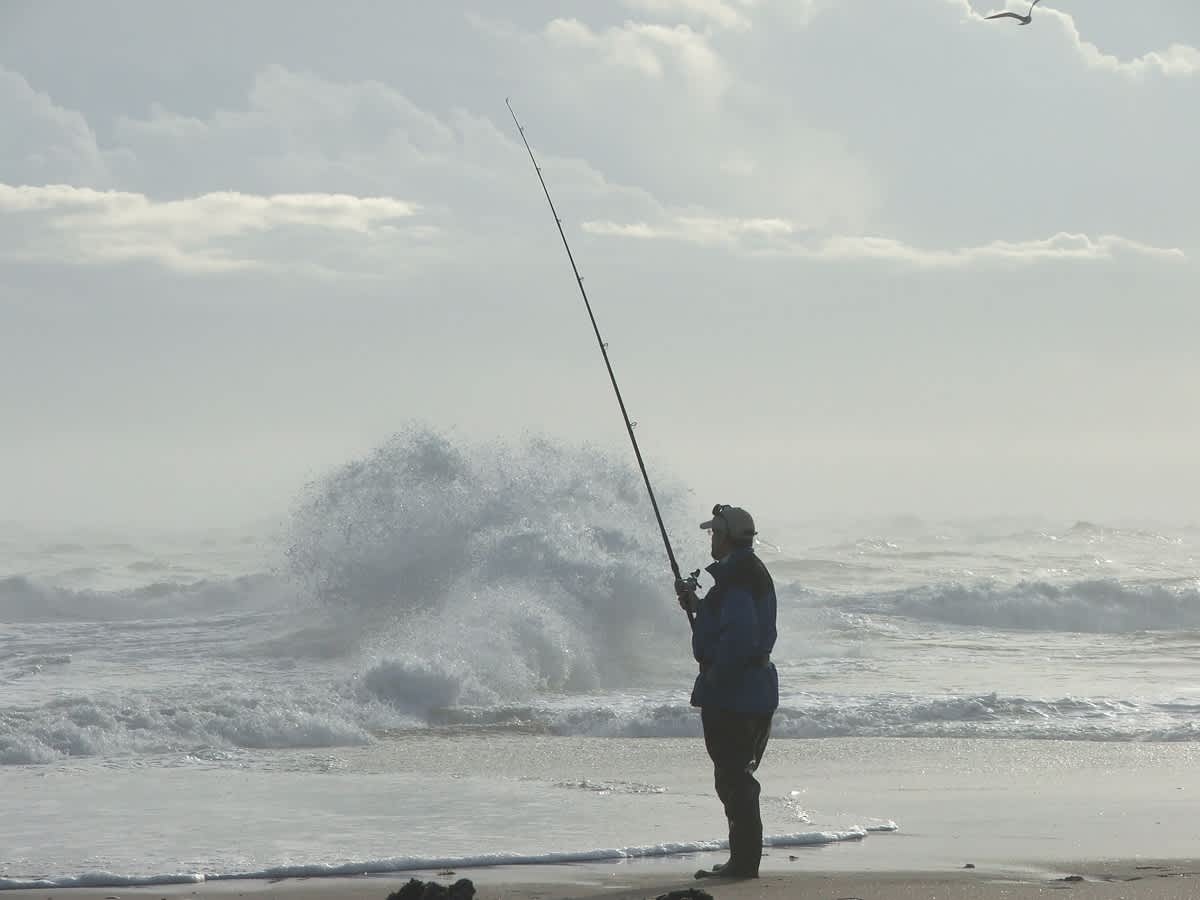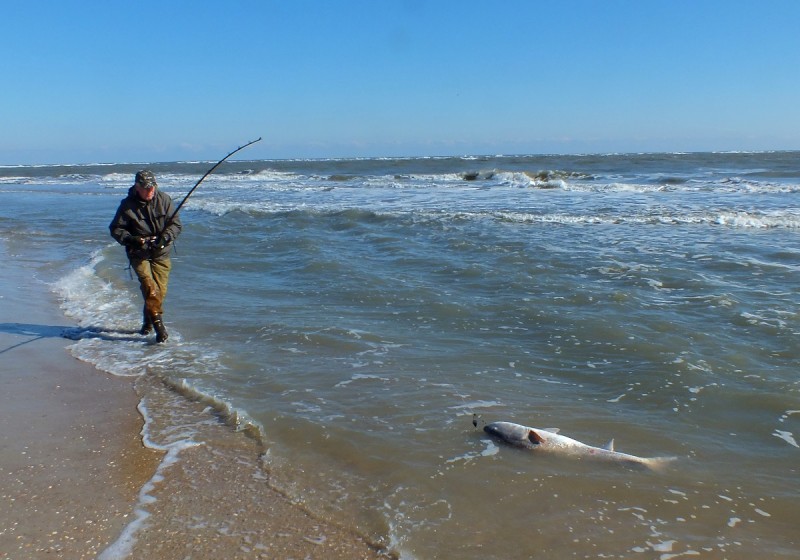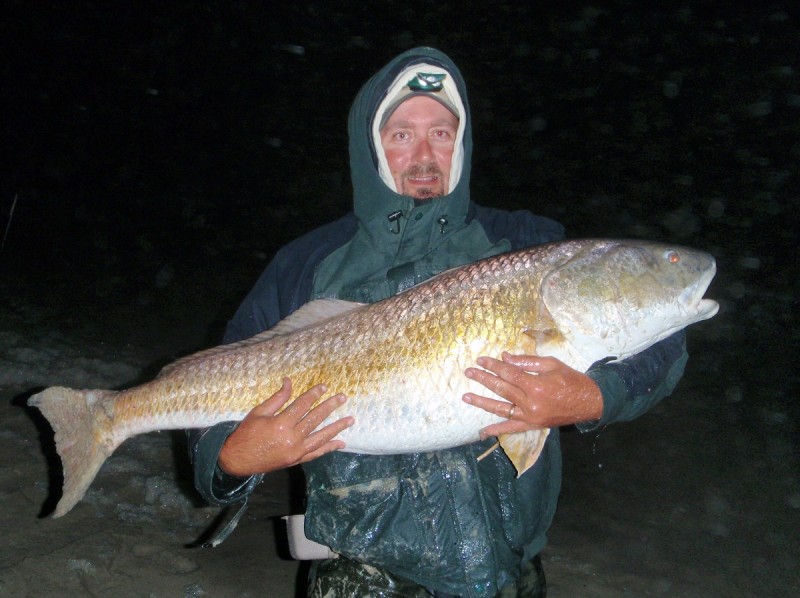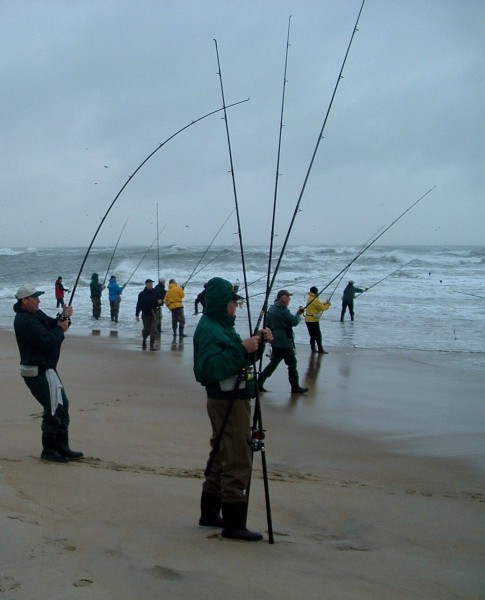A Guide to Line Choices for Catching Big Redfish in the Surf
Lewis Creek Shooting School 08.31.15

One of the most hallowed beaches for surf fishing in the world is the point of Cape Hatteras, North Carolina. But there’s another less-frequented but very similar location in Cape Lookout about 70 miles to the southwest. Like Cape Hatteras, Cape Lookout is a promontory point that juts out into the Atlantic and is constantly affected by currents, tides, and storms. At both locations, the sun rises and sets over water and both the northern and southern beaches serve as an obstacle for bait and predator fish traveling with currents.
Both these locations draw anglers from all over the world in the chase for surf-zone saltwater species. The king of saltwater surf species is the redfish, or as they’re called in the Carolinas, the red drum. The last two world-record red drum were landed on the beaches of Cape Hatteras, the most recent being a 94-pound beast, caught by David Duel on November 7, 1984, at Avon, North Carolina, just a few miles north of Cape Hatteras. The previous world record also came from a Hatteras beach and weighed 92 pounds.
Fish of this magnitude require quality equipment to land, but they also require serious tackle just to present the baits where they need to be. Red drum in the surf are normally caught on bait that’s on the bottom. While they’ll take lures when schooled up or in quiet water, most are caught in current over structure like holes and channels created by storms and currents. While these structures can be within an easy cast, they’re often more than 100 yards off the beach, requiring extremely long casts. These problems are compounded by the number of anglers vying for the fish when conditions are optimal. It’s not unusual to see 50 anglers standing shoulder to shoulder fishing the point of Hatteras. When the fish are there, there can be five to 10 fish hooked up, with anglers negotiating their fish through the lines until they clear the crowd up or down the beach.

While spinning tackle works well, most seasoned drum fishermen use mid-sized casting reels in the Abu 7000 class. Casting reels provide more distance and control, are lighter, and have the cranking handle closer to the center of the rod, which makes a difference in comfort when winding in a really large fish. Non level wind reels are the norm, providing more distance and eliminating the chance of a backlash when the shock leader knot passes through the level wind guide.
The currents present when fish are feeding require a substantial sinker to keep the bait in place, with a normal sinker weighing eight ounces. Rods should be rated to handle 10 ounces when you consider the sizable chunk of mullet or menhaden used as a bait. Normal lengths range from 11 to 13 feet to provide long casts.
All these complications are compounded by the fact that most fish are caught at night and other than the moon, stars, small flashlights, and headlamps, there’s no light. Tangles are inevitable and occur often. I’m sure many reading this are wondering why anyone would fish in such chaotic conditions, but difficulty drives surf anglers as it does all anglers, and the challenge only increases the reward. Hooking up with a citation red drum on a 12-foot surf rod feels like being hooked up to a rodeo bull, and the pull on that long rod is similar to the pull of a fish several times that size on a short boat rod.
Since the rod has to be long and with a high modulus to heave an eight-ounce sinker with a substantial chunk of bait a hundred yards or more, the fish has a mechanical advantage of about five to one. While the angler has 30 inches of rod between his hands, the fish has the rest of an 11- to 13-foot rod to exert pressure. With 20-pound test stressed to its limit, bringing the rod tip back is like lifting 100 pounds, and if the line breaks, the instant release of pressure can make an angler fall backwards. There is simply no angling experience like it.

In any fishing situation, the line is the interface between the angler and the quarry. Line selection under these circumstances is critical, since the line must be strong and abrasion resistant. It must be easy to cast because of the distances often required to get to the fish, and it must be visible in low-light conditions. It also needs to be easy to join to a heavy leader with a knot, because a heavy shock leader is required to handle the casting load and bring a 50-pound fish on the beach in rough surf. The normal practice is to fish with 20-pound test and tie on a 40- or 50-pound shock leader that’s roughly twice the length of the rod. This allows horsing the fish a bit more once there are a few wraps of shock leader on the reel spool.
Since tangles are inevitable, identifying your line in a tangle is really important. While most surf anglers use green line, Stren Hi-Vis Gold provides a color related advantage in surf fishing. In low light, it’s easy to see. When illuminated by a beam of light, it’s brilliant. Since most other lines are green, the color difference helps identify your line in a tangle, allowing you to disentangle yourself from another angler’s line.

For fishing away from the crowd, where tangles and precise visibility aren’t as much of an issue, Berkley Fireline and other braids work well, provided you’re using spinning tackle. The toughness is an asset and the remarkable sensitivity allows you to feel your sinker turn over even in heavy surf. With extremely high rod loads occurring while casting heavy sinkers, braid tends to bury into the spool of casting reels and can create backlashes under heavy surf fishing conditions.
Surf fishing is challenging, but the rewards of standing in the surf and slugging it out with a big redfish on his home turf is a rewarding fishing experience you’ll remember forever. The experience is enhanced even more when you heft your fish for a release back to the wild surf he came from, so that fish might provide a lifetime memory for another angler at another time.

